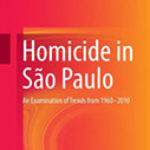The Street Casino: Survival in Violent Street Gangs

Author: Simon Harding
Publisher: Bristol, UK; Chicago, IL: Policy Press, 2014. 327 p.
Reviewer: Jana Grekul | November 2015
In The Street Casino: Survival in Violent Street Gangs, Simon Harding offers readers a look into the lives of street gang members in the London borough of Lambeth’s SW9 postcode area (roughly a neighborhood). Approaching the topic from the perspective of someone who has lived and worked in this area he explores the issue of gangs in London, their increasingly violent activities, the organizational elements, behavioural dynamics, and power relationships of these groups, and the perceived inevitability of involvement for many young people. His use of the casino metaphor provides the overarching framework for the study and sheds light on the thought processes (conscious or not) that influence decisions to join street gangs, continue involvement, and consider leaving by likening involvement to a ‘game’ involving players who must understand the rules of the game in order to survive. Harding weaves into his analysis Bourdieu’s field theory and the significance of street capital to playing the game. Street capital “acts as a way of measuring, accrediting and exchanging types of capital in the gang’s social field” (p. 6) and encompasses a range of types of knowledge and skills (e.g. street knowledge and street skills, internalized behaviours and ways of being and thinking, local history, family connections, networks, reputation, status, levels of recognition, honour and prestige, etc.)(p. 6). Through his use of field theory, the concept of street capital, and his casino metaphor, Harding offers the reader a theoretical analysis of the gang situation in SW9 that is accessible, current, and highly engaging.
The first chapter of The Street Casino introduces the issue of street gangs, provides a description of the nature of the study, and briefly presents Harding’s street casino metaphor for his analysis. Chapter Two provides the academic context and background related to gang research in the UK. The third chapter is a highly accessible account of the formal theory underpinning Harding’s study. He clearly presents the key concepts in Bourdieu’s field theory and then applies them to the social field of the gang. It is also in this chapter that he presents what will become critical to his analysis of street gangs – the concepts of social capital and street capital as they relate to the social field of the gang and survival in violent street gangs. Harding’s main point is that activities within the social field of the gang are largely influenced, if not determined by habitus. Rules for behaviours are established, and, in order to survive and play the game, players must learn these rules. The next ten chapters are used to develop his theoretical analysis of violent street gangs in the London borough of Lambeth, and specifically the SW9 postcode area, grounding the words and experiences of his research subjects in field theory. In the process he develops a detailed, well thought-out theory that explains the behaviours of individuals, groups, families, and authorities directly and indirectly connected to street gangs, using the metaphor of the street casino. For example, in Chapter Six, “Playing the game: generating and keeping your chips,” Harding examines how prospective players or gang members must work to accumulate starting chips before being invited to join ‘the game.’ These casino chips come in the form of generating respect and developing a reputation amounting to street capital. He provides details, through the words of his research participants, on how this is accomplished: the tactics used, the actions required, and the risks taken. He also details how chips can be lost, negatively affecting a player’s position in the field/game.
A personal favourite of mine is Chapter Twelve “Playing the queen: Gender in the gang”. Here Harding offers a nuanced look at the changing roles of females who are affiliated with gangs. He sets the chapter up nicely by reviewing traditional gang research perspectives on girls in gangs – some of the classic US and UK work. From this he builds his analysis based on contemporary experiences and illustrates the gendered nature of street life. Through the experiences and voices of the youth he interviewed, Harding explains how females navigate the terrain of the street and gang life in a different manner than males. They have to. Similar to men, women must grasp opportunities to build power and influence however the opportunities available to them tend to require more social skill and less reliance on physical prowess and violence. Thus, for women to be successful in these groups they must also understand the rules of the game but need to be clear on how the rules apply to them, as females, and must rely primarily on their social skills and networks within the social field to build social capital. This chapter adds significantly to our understanding of the gendered nature of gangs and street life; Harding’s theoretical framework helps to explicate the various roles available to females navigating the social field of the gang.
Harding successfully develops his theory of street capital field analysis and in so doing sheds important light on the lives of gang members in SW9. He offers a “powerful counterpoint” to the commonplace views of gangs as being “messy” and disorganized, “an obsessive media invention, moral panic, or myth” (265), or else groups comprised of psychologically unstable individuals, to name a few. In grounding his analysis in the reality and experiences of the field and its members, Harding offers insight into the rules for determining winners or losers — whereby everyone in the field must play, whereby rules change and players continue to play even when payoffs are meagre. Perhaps most significantly, players must play because it is the only game in town available to many of them.
By dispelling myths about gangs and gang members, Harding is able to show that the social field of the gang has an order to it, rules, expectations, ‘etiquettes’ as it were, that determine the behaviour of people directly and indirectly involved in the lifestyle. Significantly, he also shows that gang members are not necessarily psychologically disturbed maniacs with a penchant for guns, drug use, and violence. Rather, these are individuals growing up in neighbourhoods where learning the habitus of the social field of the gang – learning the rules of the game – is normative because for some it is the only game that is a viable option for making money and feeling a sense of belonging. In other words, these youth are not aberrant others – they are members of the community (274). In this way, he offers a more empathetic understanding of young peoples’ involvement in gangs, including the purposes these groups serve and the voids they fill for youth who slip through the cracks of legitimate social institutions. For Harding, this victim-centred approach extends to families and communities as well. These groups are also pulled into the social field of the gang, experience the effects of gangs in their neighbourhoods, and are not always the malignant influences on gang affiliates that the risk factor paradigm would have us believe.
But this victim-centred approach does not deny the violence committed by gang affiliates, nor does it downplay the violent victimization experienced by members, non-members, and communities. Harding’s research does however, lead to tangible policy implications which he outlines in his concluding chapter. For example, knowledge of the hierarchical structure of these gangs, including the age ranges linked to various positions, roles and responsibilities in the pecking order, has important implications for agencies and youth workers. Understanding the roles of members, including the types of victimization risk they face, provides opportunities for intervention. Identification of field position — particularly for new arrivals (notably recent immigrants) who are at increased risk of victimization because they are unfamiliar with the social field and habitus — could be a meaningful way for youth workers and agencies to address needs faced by these individuals and perhaps work to prevent gang involvement.
If pressed for a ‘critique,’ I have but three minor comments. First, throughout the chapters, there are numerous references to the use of social media and the activities of street gangs. It seemed that this area could possibly have been explored in more detail. One of Harding’s objectives is to explore the changing nature of street gang activities; it seems that the use of social media has contributed significantly to these changes. A more nuanced investigation into the relevance of social media to the changes in street gang activity that are occurring would have been fascinating. Second, Harding also alludes to gender-related roles throughout the book. I was left questioning the role of women in these groups. He does an excellent job of discussing women’s roles in Chapter Twelve, but I think again, a more nuanced examination of the gendered nature of gangs throughout the text would have also been informative, especially since it seems that females play a fairly important role in these groups. Third, the text is quite specific to the SW9 area in London. I wonder about its applicability to the issue of street gangs in North America and elsewhere. Certainly the application of field theory would seem universal, but some of the specific examples and instances related to SW9 might make this text primarily relevant to gang researchers, frontline workers and policy makers in the UK. This is not really a critique as much as an invitation for other gang researchers to consider the relevance of Harding’s theoretical framework to their own research and to different jurisdictions.
Jana Grekul is Associate Professor and Director of the Criminology Program at the University of Alberta, Canada, Department of Sociology.


